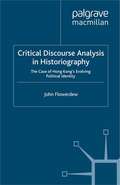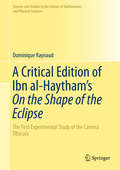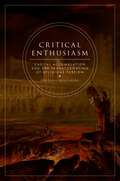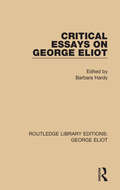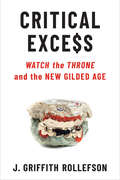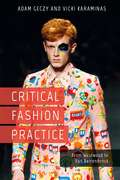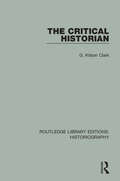- Table View
- List View
Critical Discourse Analysis in Historiography: The Case of Hong Kong's Evolving Political Identity
by J. FlowerdewThe book shows how the study of the evolving discourse employed during a political process spanning more than a decade can provide insights for critical discourse analysis, on the one hand, and understanding of a real world political process on the other, thereby demonstrating the potential role for critical discourse analysis in historiography.
A Critical Edition of Ibn al-Haytham’s On the Shape of the Eclipse: The First Experimental Study of the Camera Obscura (Sources and Studies in the History of Mathematics and Physical Sciences)
by Dominique RaynaudThis book provides the first critical edition of Ibn al-Haytham’s On the Shape of the Eclipse with English translation and commentary, which records the first scientific analysis of the camera obscura. On the Shape of the Eclipse includes pioneering research on the conditions of formation of the image, in a time deemed to be committed to aniconism. It also provides an early attempt to merge the two branches of Ancient optics—the theory of light and theory of vision. What perhaps most strongly characterizes this treatise is the close interaction of a geometric analysis of light and experimental reasoning. Ibn al-Haytham conducted his experiments in a systematic way by varying all that could be changed: the shape and size of the aperture, the focal length of the camera obscura, the distance and shape of the celestial bodies. This way, he achieved a thorough understanding. This work represents a decisive step in both the history of optics and the application of the experimental method that was just as efficient in medieval Islam as today.
Critical Enthusiasm: Capital Accumulation and the Transformation of Religious Passion
by Jordana RosenbergCritical Enthusiasm tracks the intertwined histories of religious radicalism and economic transformation in the long eighteenth century. Rosenberg situates the rhetoric of enthusiastic rapture in the context of the major institutional transformations of early modernity: the dispossession and plunder of the globe, the rise of finance, legal reform, and the administration of racialized labor.
Critical Essays in Music Education
by Marvelene C. MooreThis volume of essays references traditional and contemporary thought on theory and practice in music education for all age groups, from the very young to the elderly. The material spans a broad range of subject areas from history and philosophy to art and music, and addresses issues such as curriculum, pedagogy, assessment and evaluation, as well as current issues in technology and performance standards. Written by leading researchers and educators from diverse countries and cultures, this selection of previously published articles, research studies and book chapters is representative of the most frequently discussed and debated topics in the profession. This volume, which documents the importance of lifelong learning, is an indispensable reference work for specialists in the field of music education.
Critical Essays in Music Education
by MarveleneC. MooreThis volume of essays references traditional and contemporary thought on theory and practice in music education for all age groups, from the very young to the elderly. The material spans a broad range of subject areas from history and philosophy to art and music, and addresses issues such as curriculum, pedagogy, assessment and evaluation, as well as current issues in technology and performance standards. Written by leading researchers and educators from diverse countries and cultures, this selection of previously published articles, research studies and book chapters is representative of the most frequently discussed and debated topics in the profession. This volume, which documents the importance of lifelong learning, is an indispensable reference work for specialists in the field of music education.
Critical Essays on George Eliot (Routledge Library Editions: George Eliot)
by Barbara HardyThis title, first published in 1970, consists of essays on the individual tales and novels of George Eliot, with two general essays that discuss the novels as a whole and cuts across the individual works. The primary concern of these studies is to see what the limits of George Eliot’s greatness are, to consider the purpose and end of the technical brilliance, and to attend to what she has to say to us across a century of change and developing historical and psychological consciousness. This book will be of interest to students of literature.
Critical Essays on George Eliot (Routledge Library Editions: George Eliot #4)
by Barbara HardyThis title, first published in 1970, consists of essays on the individual tales and novels of George Eliot, with two general essays that discuss the novels as a whole and cuts across the individual works. The primary concern of these studies is to see what the limits of George Eliot’s greatness are, to consider the purpose and end of the technical brilliance, and to attend to what she has to say to us across a century of change and developing historical and psychological consciousness. This book will be of interest to students of literature.
A Critical Examination of Psycho-Analysis (Routledge Library Editions: Psychoanalysis)
by A. WohlgemuthOriginally published in 1923, this title is a critical examination of Freud’s theory of psychoanalysis. A contemporary of Freud, the author sets out to evaluate his theories in a scientific manner, searching for evidence. The result is a rather scathing review of where this is lacking.
A Critical Examination of Psycho-Analysis (Routledge Library Editions: Psychoanalysis)
by A. WohlgemuthOriginally published in 1923, this title is a critical examination of Freud’s theory of psychoanalysis. A contemporary of Freud, the author sets out to evaluate his theories in a scientific manner, searching for evidence. The result is a rather scathing review of where this is lacking.
Critical Excess: Watch the Throne and the New Gilded Age (Tracking Pop)
by J. Griffith RollefsonJay-Z and Kanye West’s 2011 Watch the Throne is a self-avowed “luxury rap” album centered on Eurocentric conceptions of nobility, artistry, and haute couture. Critical Excess performs a close reading of the sonic and social commentary on this album, examining how the album alternately imagines and critiques the mutually reinforcing ideas of Europe, nobility, old money, art, and their standard bearer, whiteness. Reading the album alongside Black critical theory and work on the prophetic nature of music, Rollefson argues that through their performance of black excellence, opulence, and decadence, Jay-Z and Kanye West poured gas on the white resentment of the Obama presidency—a resentment that would ultimately spill over into public life, make audible the dog whistling of the Far Right, and embolden white supremacists to come out from under their rocks. Ultimately, Rollefson argues, Jay-Z and Kanye West’s performance of what Rollefson calls “critical excess” on this album exceeds the limits of conspicuous consumption and heralds the final stage of late capitalism—“the New Gilded Age.”
A Critical Exposition of the Popular 'Jihád' (The World At War)
by Cherágh AliA Critical Exposition of the Popular 'Jihád' Showing that all the Wars of Mohammad Were Defensive; and that Aggressive War, or Compulsory Conversion, is not Allowed in The Koran - 1885
Critical Fashion Practice: From Westwood to Van Beirendonck
by Adam Geczy Vicki KaraminasThere is a new form of design practice within the contemporary fashion industry which is active in complex forms of social commentary and critique. While fashion in the modernist era has shown signs of criticism and subversion, these were either in the form of subcultures or perversions, such as punk or BDSM styling. Today, however, these genres have been absorbed into the fashion industry itself, meaning that "critical fashion†? is now far from limited to the subcultures from which it came. This book explores this new space for criticism within the popular fashion sphere to demonstrate how designers are disrupting conventions, challenging beliefs and stirring change from within the system itself.Critical Fashion Practice considers a range of contemporary designers across the globe, from the US to Japan, whose conceptual designs embody this critical language, including case studies such as Rei Kawakubo's deconstructive silhouettes for Comme des Garçons and Walter Van Beirendonck's sadomasochistic menswear collections, amongst other key players such as Miuccia Prada, Vivienne Westwood and Viktor & Rolf. Arguing that the rise of critical fashion coincides with a noticeable decline in the criticality of art, Geczy and Karaminas go beyond slotting fashion into previously established art theories. Conceiving a new cultural role for fashion that affords insight into identity, class, race, sexuality and gender, this book shows how fashion can not only reflect and comment on, but can also be a part of social change.
Critical Fashion Practice: From Westwood to Van Beirendonck
by Adam Geczy Vicki KaraminasThere is a new form of design practice within the contemporary fashion industry which is active in complex forms of social commentary and critique. While fashion in the modernist era has shown signs of criticism and subversion, these were either in the form of subcultures or perversions, such as punk or BDSM styling. Today, however, these genres have been absorbed into the fashion industry itself, meaning that “critical fashion” is now far from limited to the subcultures from which it came. This book explores this new space for criticism within the popular fashion sphere to demonstrate how designers are disrupting conventions, challenging beliefs and stirring change from within the system itself.Critical Fashion Practice considers a range of contemporary designers across the globe, from the US to Japan, whose conceptual designs embody this critical language, including case studies such as Rei Kawakubo's deconstructive silhouettes for Comme des Garçons and Walter Van Beirendonck's sadomasochistic menswear collections, amongst other key players such as Miuccia Prada, Vivienne Westwood and Viktor & Rolf. Arguing that the rise of critical fashion coincides with a noticeable decline in the criticality of art, Geczy and Karaminas go beyond slotting fashion into previously established art theories. Conceiving a new cultural role for fashion that affords insight into identity, class, race, sexuality and gender, this book shows how fashion can not only reflect and comment on, but can also be a part of social change.
The Critical Historian (Routledge Library Editions: Historiography)
by G Kitson ClarkOriginally published in 1967, this book analyses the method by which historical evidence is built up and compares the nature of historical proof with that of other disciplines such as the law and natural sciences. It examines an extraordinary series of forgeries and distortions from the False Decretals to the biographies of Lytton Strachey, as well as discussing how an historical reputation such as that enjoyed by Judge Jefferies was created.
The Critical Historian (Routledge Library Editions: Historiography)
by G Kitson ClarkOriginally published in 1967, this book analyses the method by which historical evidence is built up and compares the nature of historical proof with that of other disciplines such as the law and natural sciences. It examines an extraordinary series of forgeries and distortions from the False Decretals to the biographies of Lytton Strachey, as well as discussing how an historical reputation such as that enjoyed by Judge Jefferies was created.
A Critical History and Philosophy of Psychology: Diversity of Context, Thought, and Practice (PDF)
by Richard Walsh Thomas Teo Angelina Baydala Tony WalshIn line with the British Psychological Society’s recent recommendations for teaching the history of psychology, this comprehensive undergraduate textbook emphasizes the philosophical, cultural, and social elements that influenced psychology’s development. The authors demonstrate that psychology is both a human (i.e., psychoanalytic or phenomenological) and natural (i.e., cognitive) science, exploring broad social-historical and philosophical themes such as the role of diverse cultures and women in psychology, and the complex relationship between objectivity and subjectivity in the development of psychological knowledge. The result is a fresh and balanced perspective on what has traditionally been viewed as the collected achievements of a few “great men.” With a variety of learning features, including case studies, study questions, thought experiments, and a glossary, this new textbook encourages students to critically engage with chapter material and analyze themes and topics within a social, historical, and philosophical framework.
A Critical History of Contemporary Architecture: 1960-2010
by Elie G. Haddad David Rifkind1960, following as it did the last CIAM meeting, signalled a turning point for the Modern Movement. From then on, architecture was influenced by seminal texts by Aldo Rossi and Robert Venturi, and gave rise to the first revisionary movement following Modernism. Bringing together leading experts in the field, this book provides a comprehensive, critical overview of the developments in architecture from 1960 to 2010. It consists of two parts: the first section providing a presentation of major movements in architecture after 1960, and the second, a geographic survey that covers a wide range of territories around the world. This book not only reflects the different perspectives of its various authors, but also charts a middle course between the 'aesthetic' histories that examine architecture solely in terms of its formal aspects, and the more 'ideological' histories that subject it to a critique that often skirts the discussion of its formal aspects.
A Critical History of Contemporary Architecture: 1960-2010
by Elie G. Haddad David Rifkind1960, following as it did the last CIAM meeting, signalled a turning point for the Modern Movement. From then on, architecture was influenced by seminal texts by Aldo Rossi and Robert Venturi, and gave rise to the first revisionary movement following Modernism. Bringing together leading experts in the field, this book provides a comprehensive, critical overview of the developments in architecture from 1960 to 2010. It consists of two parts: the first section providing a presentation of major movements in architecture after 1960, and the second, a geographic survey that covers a wide range of territories around the world. This book not only reflects the different perspectives of its various authors, but also charts a middle course between the 'aesthetic' histories that examine architecture solely in terms of its formal aspects, and the more 'ideological' histories that subject it to a critique that often skirts the discussion of its formal aspects.
A Critical History of Economics
by John MillsJohn Mills provides a critical survey of the way economics has developed. He argues that the main goal of economics ought to be to show how to achieve a combination of economic growth, full employment, low inflation, avoidance of extreme poverty and sustainability. That it has failed to do so is neither inevitable nor accidental. It has failed because of a combination of intellectual error and the effects of social and political pressure, which Mills claims could and should have been avoided.
A Critical History of Health Films in Central and Eastern Europe and Beyond (Routledge Open History)
by Victoria Shmidt Karl KaserThe burgeoning scholarship on Western health films stands in stark contrast to the vacuum in the historical conceptualization of Eastern European films. This book develops a nonlinear historical model that revises their unique role in the inception of national cinematography and establishing supranational health security. Readers witness the revelation of an unknown history concerning how the health films produced in Eastern European countries not only adopted Western patterns of propaganda but actively participated in its formation, especially with regard to those considered “others”: Women and the populations of the periphery. The authors elaborate on the long “echo” of the discursive practices introduced by health films within public health propaganda, as well as the attempts to negate and deconstruct such practices by rebellious filmmakers. A wide range of methods, including the analysis of the sociological biographies of filmmakers, the historical reconstruction of public campaigns against diseases and an investigation into the production of health films, contextualizes these films along a multifaceted continuum stretching between the adaptation of global patterns and the cultivation of national authenticities. The book is aimed at those who study the history of film, the history of public health, Central and Eastern European countries and global history.
A Critical History of Health Films in Central and Eastern Europe and Beyond (Routledge Open History)
by Victoria Shmidt Karl KaserThe burgeoning scholarship on Western health films stands in stark contrast to the vacuum in the historical conceptualization of Eastern European films. This book develops a nonlinear historical model that revises their unique role in the inception of national cinematography and establishing supranational health security. Readers witness the revelation of an unknown history concerning how the health films produced in Eastern European countries not only adopted Western patterns of propaganda but actively participated in its formation, especially with regard to those considered “others”: Women and the populations of the periphery. The authors elaborate on the long “echo” of the discursive practices introduced by health films within public health propaganda, as well as the attempts to negate and deconstruct such practices by rebellious filmmakers. A wide range of methods, including the analysis of the sociological biographies of filmmakers, the historical reconstruction of public campaigns against diseases and an investigation into the production of health films, contextualizes these films along a multifaceted continuum stretching between the adaptation of global patterns and the cultivation of national authenticities. The book is aimed at those who study the history of film, the history of public health, Central and Eastern European countries and global history.
A Critical History of Poverty Finance: Colonial Roots and Neoliberal Failures
by Nick Bernards'The definitive account of the history of poverty finance' - Susanne SoederbergFinance, mobile and digital technologies - or 'fintech' - are being heralded in the world of development by the likes of the IMF and World Bank as a silver bullet in the fight against poverty. But should we believe the hype? A Critical History of Poverty Finance demonstrates how newfangled 'digital financial inclusion' efforts suffer from the same essential flaws as earlier iterations of neoliberal 'financial inclusion'. Relying on artificially created markets that simply aren’t there among the world's most disadvantaged economic actors, they also reinforce existing patterns of inequality and uneven development, many of which date back to the colonial era.Bernards offers an astute analysis of the current fintech fad, contextualised through a detailed colonial history of development finance, that ultimately reveals the neoliberal vision of poverty alleviation for the pipe dream it is.
A Critical History of Poverty Finance: Colonial Roots and Neoliberal Failures
by Nick Bernards'The definitive account of the history of poverty finance' - Susanne SoederbergFinance, mobile and digital technologies - or 'fintech' - are being heralded in the world of development by the likes of the IMF and World Bank as a silver bullet in the fight against poverty. But should we believe the hype? A Critical History of Poverty Finance demonstrates how newfangled 'digital financial inclusion' efforts suffer from the same essential flaws as earlier iterations of neoliberal 'financial inclusion'. Relying on artificially created markets that simply aren’t there among the world's most disadvantaged economic actors, they also reinforce existing patterns of inequality and uneven development, many of which date back to the colonial era.Bernards offers an astute analysis of the current fintech fad, contextualised through a detailed colonial history of development finance, that ultimately reveals the neoliberal vision of poverty alleviation for the pipe dream it is.
A Critical History of Schizophrenia (Palgrave Studies in the Theory and History of Psychology)
by Kieran McNallySchizophrenia was 20th century psychiatry's arch concept of madness. Yet for most of that century it was both problematic and contentious. This history explores schizophrenia's historic instability via themes such as symptoms, definition, classification and anti-psychiatry. In doing so, it opens up new ways of understanding 20th century madness.
Critical Insights on Colonial Modes of Seeing Cattle in India: Tracing the Pre-history of Green and White Revolutions (Asia in Transition #27)
by Himanshu UpadhyayaThis book traces the contours of the symbiotic relationship between crop cultivation and cattle rearing in India by reading against the grain of several official accounts from the late colonial period to the 1980s. It also skillfully unpacks the multiple cultural expressions that revolve around cattle in India and the wider subcontinent to show how this domestic animal has greatly impacted political discourses in South Asia from colonial times, into the postcolonial period. The author begins by demonstrating the dependence between the nomadic cattle breeder and the settled cultivator, at the nexus of land-livestock-agriculture, as indicated in the writings of Sir Albert Howard, who espoused some of the most sophisticated ideas on integration, holism, and mixed farming in an era when agricultural research was marked by increasing specialisation and compartmentalisation. The book springboards with the views of colonial experts who worked at imperial science institutions but passionately voiced dissenting opinions due to their emotional investment in the lives of Indian peasants, of whom Howard was a leading light. The book presents Howard and his contemporaries’ writings to then engage contemporary debates surrounding organic agriculture and climate change, tracing the path out of the treadmill of industrial agriculture and factory farming. In doing so, the book shows how, historically, animal rearing has been critically linked to livelihood strategies in the Indian subcontinent. At once a dispassionate reflection on the role played by cattle and water buffaloes in not just supporting farm operations in the agro-pastoral landscape, but also in contributing to millions of livelihoods in sustainable ways while fulfilling the animal protein in the Indian diet, the book presents contemporary lessons on development perspectives relating to sustainable and holistic agriculture. A rich and sweeping treatment of this aspect of environmental history in India that tackles the transformations prompted by the arrival of veterinary medicine, veterinary education and notions of scientific livestock management, the book is a rare read for historians, environmentalists, agriculturalists, development practitioners, and animal studies scholars with a particular interest in South Asia.
